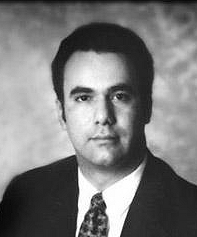

 | | 
|
|---|
| Donald Dabdub, Ph.D. |

|
|---|---|
Heterogeneous Interfacial Reactions: A New Paradigm in Atmospheric Chemistry |
Date: Friday, September 23, 2005 Location: Fountain Blue Banquets map
2300 South Mannheim Road
Des Plaines, IL 60018
Cost: $30.00 for members of ACS and their guests, $32.00 for non-members,
$15 for students or unemployed
Please REGISTER ON LINE
5:15 - 6:15 PM Job Club
5:30 - 6:30 PM Topical Group meeting with our Chair, Russell Johnson: "Who Are Tomorrow's Chemists and How Do We Reach Them: The Millennials"
6:00 PM Social Hour
7:00 PM Dinner
8:00 PM Program
Abstract:
Climate change and air pollution are two leading issues in science today. It is essential that we understand the dynamics of our atmosphere so that governments can craft proper legislation. Detailed atmospheric measurements have only been made over a relatively short period of time, and atmospheric modeling is exceedingly complex. Similarly, it is essential to know how atmospheric pollution interacts with human lungs.
Professor Dabdub will discuss the mathematical modeling of air pollution dynamics. His research is conducted in two areas: atmospheric sciences and computational sciences. Working in the area of atmospheric sciences, his work is aimed at the mathematical modeling of urban and global air pollution, understanding the dynamics of atmospheric aerosols, and global climate change. Within the realm of computational sciences, Prof. Dabdub is interested in massively parallel computations, the numerical analysis of partial differential equations, and the development of problem solving environments.
His current activities include a modeling study of Cl2 formation from aqueous NaCl particles; development of a semi-Lagrangian flux scheme for the solution of the aerosol condensation/evaporation equation; development of a two-level time-marching scheme using splines for solving the advection equation; and an investigation into the effect of alveolar volume and sequential filling on the diffusing capacity of the lungs.
This work will foster a better understanding of air pollution and the dynamics of global climate change.
Biographical Sketch: Donald Dabdub is Assistant Professor of Mechanical and Environmental Engineering at the Henry Samueli School of Engineering, University of California-Irvine Irvine, CA. He earned a B.S. from Lehigh University prior to M.S and Ph.D. degrees in Chemical Engineering from California Institute of Technology. His interests in atmospheric sciences include mathematical modeling of air pollution dynamics, dynamics of atmospheric aerosols, chemical reactions at gas-liquid interfaces, and impact of energy generation on air quality. He combines these areas with computational applied mathematics, numerical algorithms on massively parallel computers, and grid-based computations. Professor Dabdub's awards and honors include the Gaspar de Portola International Fellowship, the UCI Project Prometheus Teaching Award, the NSF CAREER Award, the W. E. Schiesser Distinguished Lecture at Lehigh University, the William Corcoran Fellowship, membership in the Tau Beta Pi National Engineering Honor Society, and membership in the Phi Eta Sigma National Honor Society.
Professional Interests:
Atmospheric Sciences: Mathematical modeling of air pollution dynamics. Dynamics of atmospheric aerosols. Chemical reactions at gas-liquid interfaces. Impact of energy generation on air quality. Computational Sciences: Applied mathematics. Numerical algorithms on massively parallel computers. Grid-based computations. Academic Positions: Assistant Professor Oct 1995-present Mechanical and Environmental Engineering. University of California, Irvine.
Awards and Honors:
Gaspar de Portola International Fellowship 2002
UCI Project Prometheus Teaching Award 2001
National Science Foundation CAREER Award 2000
W. E. Schiesser Distinguished Lecture, Lehigh University 1999
William Corcoran Fellowship 1990-1995
Tau Beta Pi National Engineering Honor Society 1987
Phi Eta Sigma National Honor Society 1986
From 290 East/West
Take 290 from either direction and exit 294 North. Continue until you reach the exit for 190 West (to O'Hare). Exit and immediately pay toll. Exit Mannheim Road North. Go North for 2 miles.
From 90 East/West
Take 90 from either direction and exit 190 West (to O'Hare). Pay toll and immediately exit Mannheim Road North. Go North for 2 miles.
From 294 North/South
Take 294 from either direction and exit 190 West (to O'Hare). Pay toll and immediately exit Mannheim Road North. Go North for 2 miles.
From 88 East
Take 88 East to 294 North. Then follow the directions for 294 North/South.
Parking: Free
- Fresh fruit cocktail
- garden salad with variety of dressings
- entrée: choice of chicken piciatta or broiled white fish, or vegetarian pasta primavera with Alfredo sauce.
- Included with chicken and fish entrees are Athenian oven roasted potatoes, peas, mushrooms, and carrots.
- Dessert, chocolate sundae.